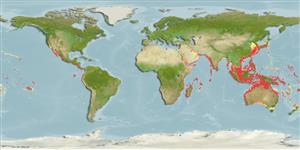Common names from other countries
>
Scombriformes (Mackerels) >
Scombridae (Mackerels, tunas, bonitos) > Scombrinae
Etymology: Sarda: Latin and Greek, sarda = sardine; name related to the island of Sardinia (Ref. 45335).
More on authors: Temminck & Schlegel.
Environment: milieu / climate zone / depth range / distribution range
ນິເວດວິທະຍາ
ສັດທະເລ; ປາທີ່ມີການເຄື່ອນຍ້າຍໃນສະເພາະມາະຫາສະມຸດ (Ref. 51243); ລະດັບຄວາມເລິກ 1 - 167 m (Ref. 58302). Subtropical; 14°C - 23°C (Ref. 168); 43°N - 41°S, 24°E - 77°W (Ref. 168)
Indo-Pacific: widespread but with many gaps in its known distribution. Eastern Pacific: Hawaiian Islands and Pacific coast of USA to southern tip of Baja California and Tres Marias Islands extending to Cabo Blanco, Peru (especially during El Niño events), the Galapagos Islands and Gulf of Guayaquil.
Length at first maturity / ຂະໜາດ / ນ້ຳໜັກ / Age
Maturity: Lm 47.8, range 45 - ? cm
Max length : 102 cm FL ຕົວຜູ້/ບໍ່ມີເພດ; (Ref. 9684); common length : 55.0 cm TL ຕົວຜູ້/ບໍ່ມີເພດ; (Ref. 55763); ນ້ຳໜັກສູງສຸດທີ່ເຄຍຈັດພີມມາ: 10.7 kg (Ref. 168)
ຄີ (ໜາມ)ແຂງຢູ່ຫຼັງປາ (ທັງໝົດ) : 17 - 19; ຄີ(ໜາມ) ແຂງຢູ່ຄີກົ້ນປາ
ກຸ່ມປາກະດູກແຂງ
ຄວາມຖີ່ຂອງກຸ່ມຖ່າຍທອດພັນ
ປາທີ່ມີການເຄື່ອນຍ້າຍຈາກທະເລໄປຫານ້ຳຈືດ ແລະນ້ຳຈືດຫາທະເລ
ປາທີ່ມີການເຄື່ອນຍ້າຍຈາກທະເລແລະໄປໄຂ່ຢູ່ນ້ຳຈືດ
ຄີກົ້ນຂອງປາ
ສັດທີ່ມີກະດູກສັນຫັຼງ
ການຖ່າຍທອດທາງກຳມະພັນຈາກພໍ່ແມ່ຫາລູກ: 0; ຄີກົ້ນຂອງປາ: 14 - 16; ສັດທີ່ມີກະດູກສັນຫຼັງ: 44 - 45. Mouth moderately large. Laminae of olfactory rosette 21 to 39. Interpelvic process small and bifid. Body completely covered with very small scales posterior to the corselet. Swim bladder absent. Spleen large and prominent in ventral view. Liver with elongate left and right lobes and a short middle lobe. Back with narrow oblique stripes.
A coastal species (Ref. 9340) found schooling with small tunas. Also found around some islands (Ref. 9684). Feeds on clupeoids, other fishes, squids and decapod crustaceans. Spawning varies with the monsoon season (Ref. 9684). Also caught with troll lines, encircling nets (Ref. 9340) and drift nets (Ref. 9684). Marketed mainly fresh; also dried-salted (Ref. 9684), canned and frozen (Ref. 9987).
Collette, B.B. and C.E. Nauen, 1983. FAO Species Catalogue. Vol. 2. Scombrids of the world. An annotated and illustrated catalogue of tunas, mackerels, bonitos and related species known to date. Rome: FAO. FAO Fish. Synop. 125(2):137 p. (Ref. 168)
IUCN Red List Status (Ref. 130435)
CITES (Ref. 128078)
Not Evaluated
Threat to humans
Harmless
Human uses
ການປະມົງ: ທີ່ເປັນການຄ້າໜ້ອຍ; ຊະນິດປາທີ່ຖືກນຳໃຊ້ເຂົ້າໃນການຫາເພື່ອເປັນເກມກິລາ: ແມ່ນ
ເຄື່ອງມື
Special reports
Download XML
ແຫຼ່ງອີນເຕີເນັດ
Estimates based on models
Preferred temperature (Ref.
115969): 20.5 - 29, mean 27.6 (based on 2552 cells).
Phylogenetic diversity index (Ref.
82804): PD
50 = 0.5312 [Uniqueness, from 0.5 = low to 2.0 = high].
Bayesian length-weight: a=0.01000 (0.00520 - 0.01924), b=3.05 (2.89 - 3.21), in cm Total Length, based on LWR estimates for this species & (Sub)family-body (Ref.
93245).
ຊັ້ນເຂດຮ້ອນ (Ref.
69278): 4.2 ±0.66 se; based on food items.
ຄວາມຢືດຢຸ່ນ (Ref.
120179): ຂະໜາດກາງ, ປະຊາກອນຕຳ່ສຸດທີ່ໃຊ້ເວລາສອງເທົ່າ 1.4 - 4.4 ປີ (Assuming tm=3-4).
Fishing Vulnerability (Ref.
59153): Moderate vulnerability (35 of 100).
Climate Vulnerability (Ref.
125649): High vulnerability (59 of 100).
